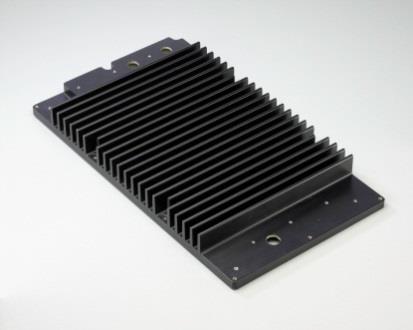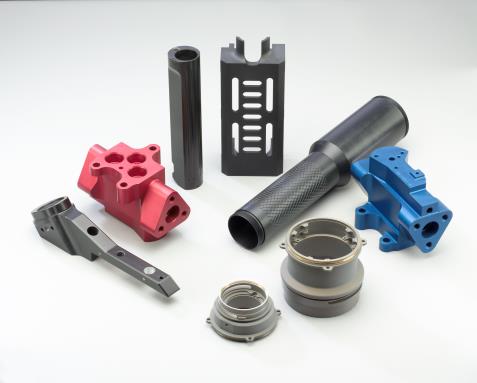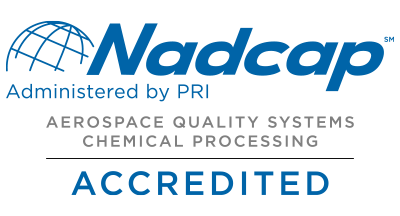A family of technical, anodic coatings on Aluminum and Titanium
Technical Data Sheet - Anoplate Anodize
Anoplate began offering anodize over aluminum from day 1 in 1960, starting with sulfuric acid anodize. Since then, its anodize coating family has grown to five anodize finishes to its product portfolio, including:
- Hardcoat Anodize
- Sulfuric Acid Anodize
- Boric-Sulfuric Acid Anodize
- Titanium Anodize
- Chromic Acid Anodize
Hardcoat Anodize:
 Hardcoat anodize, while usually done in a sulfuric acid based electrolyte, is much thicker and denser than the more conventional sulfuric anodize. Hardcoat is specified for aluminum components subject to extreme wear applications where superior abrasion resistance is needed, or corrosive environments where a thicker, harder, more durable coating is necessary. It can also be valuable where enhanced electrical insulation is required. Since hardcoat anodize can be built up to several thousandths in some cases, it makes this type of anodize a candidate for salvaging worn or mismachined components.
Hardcoat anodize, while usually done in a sulfuric acid based electrolyte, is much thicker and denser than the more conventional sulfuric anodize. Hardcoat is specified for aluminum components subject to extreme wear applications where superior abrasion resistance is needed, or corrosive environments where a thicker, harder, more durable coating is necessary. It can also be valuable where enhanced electrical insulation is required. Since hardcoat anodize can be built up to several thousandths in some cases, it makes this type of anodize a candidate for salvaging worn or mismachined components.
Anoplate is one of the premier hardcoat anodizers in the world, utilizing a combination of custom-built power supplies, optimized anodizing chemistry, and advanced process control to provide superior hardness and corrosion protection. Anoplate can certify this finish to MIL-A-8625 Type III both Class 1 and Class 2, as well as many unique customer specifications.
Hardcoat Anodize Features:
- Improved wear resistance
- Non-conductive
- Can repair worn surfaces on aluminum
- Improve parts surface for slide applications
- Can be black dyed; other colors less decorative
- Finish is harder than tool steel
- Can be ground or lapped
Hardcoat Anodize Applications:
- Moving Parts: Valves, Pistons, Gears, Cams
- Heat Sinks
- Electrical Insulation Components
- Paper Guide Rollers
- Weapon Hardware & Optical Sights
 The sulfuric acid process is the most common method for anodizing. The sulfuric acid anodize process films range from .0001"-.001" thick. The overall thickness of the coating formed is roughly 60 percent penetration in the substrate and 40 percent growth over the original dimension of the part (alloy dependent). It is particularly suited for applications where hardness and resistance to abrasion are required. However, where parts are subjected to considerable stress, (such as aircraft parts), the possible presence of the corrosive acid residue is undesirable. The porous nature of sulfuric acid films prior to sealing is significantly useful in the development of colored surface finishes on aluminum and its alloys. The porous aluminum oxide absorbs organic dyes well, and subsequent sealing helps to prevent color loss in service. Although dyed anodized films are reasonably colorfast, they have a tendency to bleach under prolonged direct sunlight. Anoplate currently offers the following colors for commercial customers: Black, Red, Blue, Green, Coyote Brown, Urban Grey, and Gold. Anoplate has the capability of treating the aluminum parts either chemically or mechanically prior to anodizing to achieve a matte (non-reflective) finish.
The sulfuric acid process is the most common method for anodizing. The sulfuric acid anodize process films range from .0001"-.001" thick. The overall thickness of the coating formed is roughly 60 percent penetration in the substrate and 40 percent growth over the original dimension of the part (alloy dependent). It is particularly suited for applications where hardness and resistance to abrasion are required. However, where parts are subjected to considerable stress, (such as aircraft parts), the possible presence of the corrosive acid residue is undesirable. The porous nature of sulfuric acid films prior to sealing is significantly useful in the development of colored surface finishes on aluminum and its alloys. The porous aluminum oxide absorbs organic dyes well, and subsequent sealing helps to prevent color loss in service. Although dyed anodized films are reasonably colorfast, they have a tendency to bleach under prolonged direct sunlight. Anoplate currently offers the following colors for commercial customers: Black, Red, Blue, Green, Coyote Brown, Urban Grey, and Gold. Anoplate has the capability of treating the aluminum parts either chemically or mechanically prior to anodizing to achieve a matte (non-reflective) finish.
Anoplate can certify this finish to MIL-A-8625 Type II both Class 1 and Class 2, as well as many unique customer specifications.
Sulfuric Acid Anodize Features:
- Less expensive than other types of Anodize
- More alloys can be finished
- Harder than chromic anodize
- Clearer finish permits dying with a greater variety of colors
Sulfuric Acid Anodize Applications:
- Optical components
- Medical device components
- Hydraulic valve bodies
- Military weapons
- Computer and electronic enclosures
Boric-Sulfuric Acid Anodize (BSAA) is an alternative to chromic acid anodize due to the environmental, worker safety and health concerns and the related costs associated with continued use of hexavalent chromiumbearing processes such as chromic acid anodize. Primary applications include aircraft and aerospace components. The application of BSAA is governed by MIL-A-8625, Type IC and many aerospace specifications including Boeing's BAC 5632. It is used for corrosion protection and paint adhesion. Paint adhesion is equal or superior to chromic acid, and the process is more energy-efficient than chrome-based processes.
Boric-Sulfuric Acid Anodize Features:
- Good for tight tolerance parts: will not change dimensions
- Corrosion protection
- Good for Bonding
- Non-Conductive
Boric-Sulfuric Acid Anodize Applications:
- Precision Machined Components
- Aerospace/Aircraft Components
- As a paint/prime base
Titanium Anodize refers to the controlled creation of an oxide film on the surface of titanium parts. Titanium anodize is used for many reasons, from part identification in the medical device community, to corrosion control and bonding in the aerospace community. Depending on the grade of titanium alloy, it can be anodized many different colors, however Anoplate only offers this finish in a blue-gray finish.
Anoplate has been relied upon to offer this finish to AMS 2488 Type II and a variety of unique customer specifications.
Titanium Anodize Features:
- Used for coloring of titanium
- Used to aid in looking for stress cracks in base
material - Improved corrosion resistance
- Improve adhesion of dry film lubricant or paint application
Titanium Anodize Applications:
- Aircraft parts
- Medical devices
- Spacecraft components
Chromic acid anodizing results in the thinnest anodic coat of the principal three types; typically on the order of .00002”-.0001” (20 to 100 microinches) per surface. While thin, when properly sealed chromic anodize affords the aluminum equal corrosion protection to the thicker sulfuric and hardcoat type anodize. Chromic acid anodize coatings, being thin, result in less of a reduction in fatigue strength than the previous two anodic coatings. Because of this, chromic acid anodize has been the “go-to” coating for airframes and other structural components on aircraft where weight, corrosion resistance, strength, and bondability are the critical design features.
 Unlike the other two previously-discussed anodic coatings, chromic anodize appears much grayer in color and being thinner absorbs less color when dyed. This limits chromic acid anodize as a decorative finish, however, it can be dyed black for use as a non-reflective, protective coating on housings for optical components.
Unlike the other two previously-discussed anodic coatings, chromic anodize appears much grayer in color and being thinner absorbs less color when dyed. This limits chromic acid anodize as a decorative finish, however, it can be dyed black for use as a non-reflective, protective coating on housings for optical components.
Anoplate has been depended on by numerous aircraft component manufacturers to provide this coating to MIL-A- 8625 Type I Class 1 or 2, or to their own corporate specifications.
Chromic Acid Anodize Features:
- Good for tight tolerance parts: will not change dimensions
- Can be black dyed - other colors not practical
- Good for Bonding
- Non-Conductive
- Good for welded parts and assemblies
Chromic Acid Anodize Applications:
- Precision Machined Components
- Aerospace Components
- Welded components and assemblies
- As a paint/prime base
With over 50 years in existence and over 300 years of combined plating engineering experience under-roof, Anoplate is well-placed to tackle your anodizing challenge.
For questions about this process or if you would you like to discuss an application for Anoplate Anodize? Contact Us Today.
CONTACT US ONLINE
(315) 471-6143













